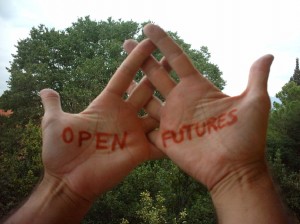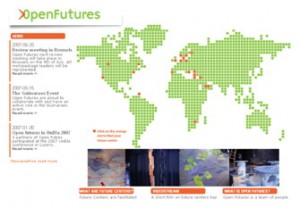In May 2006, fourteen innovation experts started a unique two-year exploration tour in which they explored Future Centers and other future-oriented working environments. They visited, experienced, analyzed and prototyped over thirty centers in the Netherlands, Sweden, Denmark, Finland, the United Kingdom, Italy, Israel and elsewhere.
The experts were part of the OpenFutures project, which was funded by the European Commission as part of the sixth framework program for collaborative working environments. OpenFutures project explored Future Centers and other future-oriented open innovation environments from four perspectives.

The Organisational Perspective – how do organisators establish, run and improve FCs? How can they integrate FC concepts into organizational strategy and structure? How does an organization create value through Future Centers?
The Methodological Perspective – which facilitation and thinking tools can be used in future-oriented open innovation and collaborative environments to enhance collaboration, future orientation, out-of-the-box thinking and “from-ideas-to-action” processes?
The Physical Perspective – how does the physical design of a Future Center impact innovation and collaboration capabilities?
The Technological Perspective – how can advanced information technologies assist in enhancing the impact of Future Centers (e.g. through creating and linking virtual Future Centers)?
OpenFutures conceptualized and packaged the learning from some 30 Future Centers and other future-oriented innovation environments into an open source “Operating System”. This is a practical guide and resource for working with FC concepts, intended for people working in existing centers, and for people who want to introduce a more systematic user-centered future orientation to their organizations through FC concepts. The operating system includes guidelines, methods, tools, best practices, “virtual tours” to existing future centers.
Benefits and results
Target group 1: organizations (public or private, from any domain) that establish a future oriented working environment, as part of their renewal and innovation strategy.
Target group 2: organizations charged with upgrading one of their existing working environments and add “a touch of future orientation” to it.
Benefits: Practical guidelines, best practices, tips and methods to support the planning, creation and operation of future centers and other future oriented collaborative working environments.
Target group 3: Living Labs family of projects
Benefits: Learning from Future Centers how to add systematic future orientation to any type of open innovation environment or living lab.
Target group 4: academics interested in understanding the dynamics of future oriented working environments.
Benefits: insights, based on real-world cases, on the four perspectives of future oriented working environments.
The insights, stories, knowledge recipes and recommendations are summarized in the book OpenFutures – an Operating System for Future Centers. It is a highly visual document, which provides insights into why Future Centers are set up, how they are managed, run and renewed, and how they provide value.
It is available through the project website: www.open-futures.net

Project start date: 1 May 2006
Project completed: 30 June 2008
